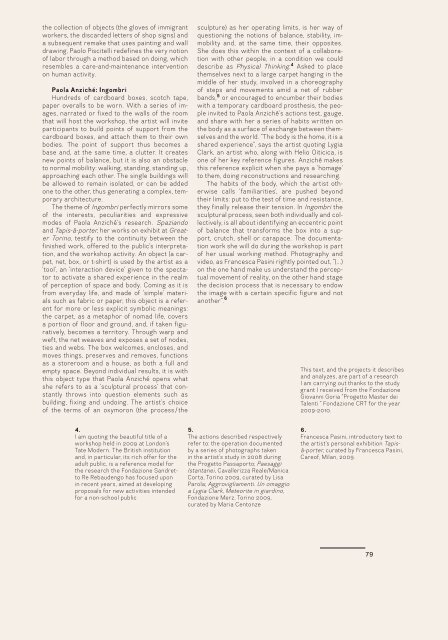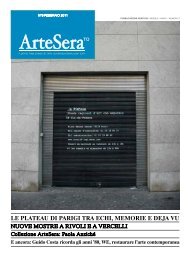Download Catalogue - Paola Anziché
Download Catalogue - Paola Anziché
Download Catalogue - Paola Anziché
Create successful ePaper yourself
Turn your PDF publications into a flip-book with our unique Google optimized e-Paper software.
the collection of objects (the gloves of immigrant<br />
workers, the discarded letters of shop signs) and<br />
a subsequent remake that uses painting and wall<br />
drawing, Paolo Piscitelli redefines the very notion<br />
of labor through a method based on doing, which<br />
resembles a care-and-maintenance intervention<br />
on human activity.<br />
<strong>Paola</strong> <strong>Anziché</strong>: Ingombri<br />
Hundreds of cardboard boxes, scotch tape,<br />
paper overalls to be worn. With a series of images,<br />
narrated or fixed to the walls of the room<br />
that will host the workshop, the artist will invite<br />
participants to build points of support from the<br />
cardboard boxes, and attach them to their own<br />
bodies. The point of support thus becomes a<br />
base and, at the same time, a clutter. It creates<br />
new points of balance, but it is also an obstacle<br />
to normal mobility: walking, standing, standing up,<br />
approaching each other. The single buildings will<br />
be allowed to remain isolated, or can be added<br />
one to the other, thus generating a complex, temporary<br />
architecture.<br />
The theme of Ingombri perfectly mirrors some<br />
of the interests, peculiarities and expressive<br />
modes of <strong>Paola</strong> <strong>Anziché</strong>’s research. Spaziando<br />
and Tapis-à-porter, her works on exhibit at Greater<br />
Torino, testify to the continuity between the<br />
finished work, offered to the public’s interpretation,<br />
and the workshop activity. An object (a carpet,<br />
net, box, or t-shirt) is used by the artist as a<br />
‘tool’, an ‘interaction device’ given to the spectator<br />
to activate a shared experience in the realm<br />
of perception of space and body. Coming as it is<br />
from everyday life, and made of ‘simple’ materials<br />
such as fabric or paper, this object is a referent<br />
for more or less explicit symbolic meanings:<br />
the carpet, as a metaphor of nomad life, covers<br />
a portion of floor and ground, and, if taken figuratively,<br />
becomes a territory. Through warp and<br />
weft, the net weaves and exposes a set of nodes,<br />
ties and webs. The box welcomes, encloses, and<br />
moves things, preserves and removes, functions<br />
as a storeroom and a house, as both a full and<br />
empty space. Beyond individual results, it is with<br />
this object type that <strong>Paola</strong> <strong>Anziché</strong> opens what<br />
she refers to as a ‘sculptural process’ that constantly<br />
throws into question elements such as<br />
building, fixing and undoing. The artist’s choice<br />
of the terms of an oxymoron (the process / the<br />
4.<br />
I am quoting the beautiful title of a<br />
workshop held in 2009 at London’s<br />
Tate Modern. The British institution<br />
and, in particular, its rich offer for the<br />
adult public, is a reference model for<br />
the research the Fondazione Sandretto<br />
Re Rebaudengo has focused upon<br />
in recent years, aimed at developing<br />
proposals for new activities intended<br />
for a non-school public<br />
sculpture) as her operating limits, is her way of<br />
questioning the notions of balance, stability, immobility<br />
and, at the same time, their opposites.<br />
She does this within the context of a collaboration<br />
with other people, in a condition we could<br />
describe as Physical Thinking. 4 Asked to place<br />
themselves next to a large carpet hanging in the<br />
middle of her study, involved in a choreography<br />
of steps and movements amid a net of rubber<br />
bands, 5 or encouraged to encumber their bodies<br />
with a temporary cardboard prosthesis, the people<br />
invited to <strong>Paola</strong> <strong>Anziché</strong>’s actions test, gauge,<br />
and share with her a series of habits written on<br />
the body as a surface of exchange between themselves<br />
and the world. “The body is the home, it is a<br />
shared experience”, says the artist quoting Lygia<br />
Clark, an artist who, along with Helio Oiticica, is<br />
one of her key reference figures. <strong>Anziché</strong> makes<br />
this reference explicit when she pays a ‘homage’<br />
to them, doing reconstructions and researching.<br />
The habits of the body, which the artist otherwise<br />
calls ‘familiarities’, are pushed beyond<br />
their limits: put to the test of time and resistance,<br />
they finally release their tension. In Ingombri the<br />
sculptural process, seen both individually and collectively,<br />
is all about identifying an eccentric point<br />
of balance that transforms the box into a support,<br />
crutch, shell or carapace. The documentation<br />
work she will do during the workshop is part<br />
of her usual working method. Photography and<br />
video, as Francesca Pasini rightly pointed out, “(...)<br />
on the one hand make us understand the perceptual<br />
movement of reality, on the other hand stage<br />
the decision process that is necessary to endow<br />
the image with a certain specific figure and not<br />
another”. 6<br />
5.<br />
The actions described respectively<br />
refer to: the operation documented<br />
by a series of photographs taken<br />
in the artist’s study in 2008 during<br />
the Progetto Passaporto; Paesaggi<br />
Istantanei, Cavallerizza Reale/Manica<br />
Corta, Torino 2009, curated by Lisa<br />
Parola; Aggrovigliamenti. Un omaggio<br />
a Lygia Clark, Meteorite in giardino,<br />
Fondazione Merz, Torino 2009,<br />
curated by Maria Centonze<br />
This text, and the projects it describes<br />
and analyzes, are part of a research<br />
I am carrying out thanks to the study<br />
grant I received from the Fondazione<br />
Giovanni Goria “Progetto Master dei<br />
Talenti ” Fondazione CRT for the year<br />
2009-2010.<br />
6.<br />
Francesca Pasini, introductory text to<br />
the artist’s personal exhibition Tapisà-porter,<br />
curated by Francesca Pasini,<br />
Careof, Milan, 2009.<br />
79



